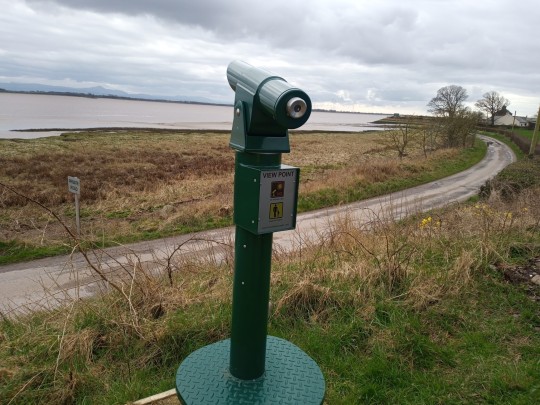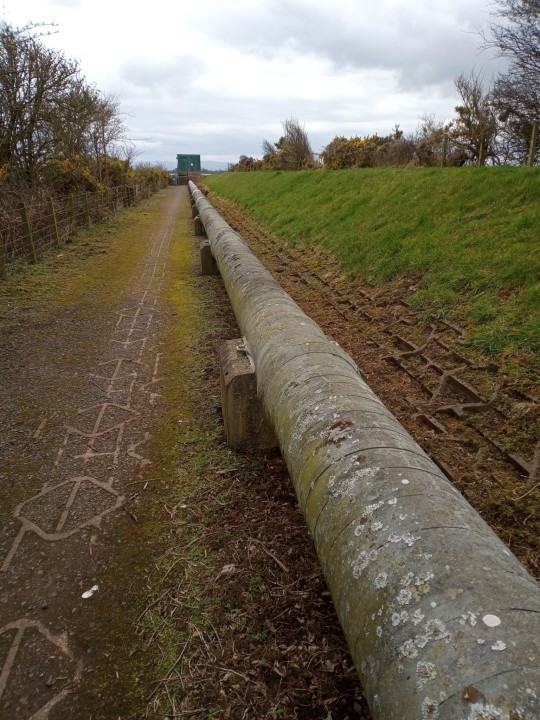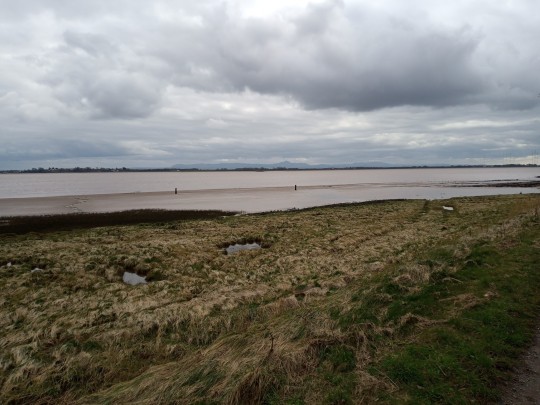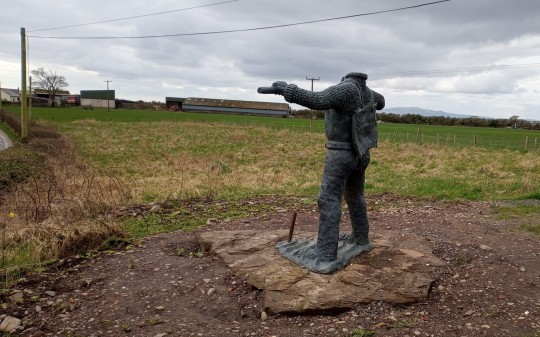#solway viaduct
Explore tagged Tumblr posts
Text

Solway Viaduct, UK
British vintage postcard
#solway#postcard#carte postale#vintage#postkarte#photography#postkaart#photo#tarjeta#solway viaduct#british#briefkaart#historic#postal#ansichtskarte#sepia#ephemera#viaduct
9 notes
·
View notes
Text
FOUR
The moon shone broad and bright upon the placid face of the Solway Firth, and showed a slight ripple upon the stakes, the tops of which were just visible above the waves.
SIR WALTER SCOTT, Redgauntlet (1824)
THE CLOCKS WENT forward today but there’d hardly be enough blue in the world to darn a sailor’s hanky. My ears, exposed after an out-of-season haircut, are red as hen’s heads as Nikki and I take in the windswept mudflats which Robert Burns called ‘this wild place of the world’. A heron pecks patina into flotsam; tuxedoed oystercatchers hurtle along the mud with their lame men’s gaits and then moan into a monochrome sky. To hoodwink their prey, plovers tap-dance on the beach pretending to be raindrops.
Three boys in shell suits stand around an observation viewer. ‘Quality’, offers the tallest of the trio, after discovering it isn’t coin-operated. He squints through it to England. ‘What the Butler saw’, I joke, ‘That’s where Edward the First cursed us before breathing his last.’ The three boys dander off, perplexed about butlers; an oyster-catcher pipes past, and a flock of timid redshanks retreats past the Altar Stane, more often than not under water, which has bounded the burgh of Annan since 1539.

Before they moved to Lochmaben Robert the Bruce’s ancestors had a castle at Annan, and a running track and park now sit beneath its tree-colonised motte. A stone from the castle, with an inscription related to the Bruces, was somehow acquired by an Annan antiquarian, who took it with him when he moved to Devon. It was returned in 1927 and is now incorporated within the town hall. There is a story that Archbishop, later Saint, Malachy put a curse on Annan. When he had dined with Bruce at the castle, Bruce had promised to spare the life of a condemned man. However, he reneged on the deal – with the result that a vampire allegedly ran loose in the town in which Thomas Carlyle later went to school.
Chop all the wood from boats that sailed in the Solway Firth, and Bonfire Night could be celebrated the length and breadth of Scotland until they launch the first zebra into space. Horn-helmeted raiders, Roman warriors, English incursors, pirates, kings, folk heroes, brigands, smugglers, and lovers. They all came and went with swords, fire, trade, romance or murder. Hadrian put his ‘Roman wall’ up at Bowness-on-Solway on the shoulder of England, a mile from where we stand – across a wath that was used by interlopers for centuries. That wath or ford can be walked when the tide is out, but you’d better know the currents intimately or you’ll be struggling in quicksand before your brain can contemplate the meaning of M’ Aidez.
From Cumberland’s tussocks – an official Area of Outstanding Natural Beauty since 1964 –trains used to smoke their way across the sea on the longest bridge in Europe. We gaze at England from a lichened mound of concrete and mudstone with mini-ferns curling out of Scotland like croziers. Behind us the trains passed through a cutting that has doubled for decades as a way for dog walkers undeterred by the pipeline running bang down the middle, through which Chapelcross Nuclear Power Station discharged its shit into the sea.


It’s March 2023. The first sod for the Solway Viaduct from Bowness-on-Solway to Annan was cut here 158 years ago today in a ceremony that featured ‘four navvies in smock frocks, red neckcloths, and white nightcaps ...... a mahogany barrow with the silver spade on their shoulders’. A cannon was fired, prayers were said, and big wigs sat in a decorated pavilion for their déjeuner à la forchette, and much speechifying and backslapping.


The idea for a viaduct had originated in 1830 in an anonymous pamphlet but The Cumberland Pacquet and Ware’s Advertiser called it ‘sublime, utopian, stupendous and bordering on certain of the Munchausen achievements’.
It took three years to build, but in 1881 ice floes wrecked it. It was repaired but it never quite recovered and was shut down in 1921. Notices went up to keep people off the bridge; however, thirsty Scots made their way across on Sundays to take advantage of more liberal English licensing laws, and there were cross-border romances for which the viaduct wasn’t a bridge too far. It was dismantled in 1935, and the scrap was recycled for armaments in Japan for its war with China. A signal box allegedly ended up being used as a garden shed.
What remains of a rusty tanker sits deck-deep in silt now behind an old warehouse that once rung with the sound of shipbuilders’ mallets. A local group pulled it out of view in 2020 with cash collected from flogging scrap bikes and shopping trolleys. Thousands of people once thronged the pier at Annan, an important shipbuilding port, whence steamers took folk to new worlds. A wooden lighthouse stood at Barnkirk point but it burned to the shore in 1975. Today a scarfed pensioner wheezes along the quay with smoky breath; and a subdued mongrel, oblivious of history, looks just as disconsolate.
Shawhill railway station, built on the verge of Annan for the viaduct traffic, is now a scrapyard. Back on the foreshore cinder path a decapitated man stands on a plinth – a bone of contention between his maker (who welds together bits of scrap and exhibits them) and others in the community, whom he regularly lambasts on his social media page. Metal Man began life in 2009 on a roundabout at the Tesco store in town, but he was beheaded in 2019. Since then, he has had a traffic cone for a head, then a football, a parrot’s head and a pig’s head. A month ago, a prankster sawed the statue’s haaf-net and fish off. Goodness knows how he ended up on the shore here where for generations real haaf-netters have battled the currents and tides.


Old Annanites speak of haaf-netting in reverential tones: it has been pursued since Viking times and is enshrined in royal charters. A haaf-net resembles a portable football goalmouth with a rectangular frame and three legs. The top beam of the frame is 18 feet long, the length of the oar of a longboat; when a fish swims into the net the frame’s legs float to the surface and the fish is netted and clobbered on the head with a nep, a priest or a killer. Well, that is what used to happen, but legislation introduced in 2016 bans the killing of salmon, and fewer and fewer men feel like paying the near £40 annual licence fee when they cannot take a single fish home. The tradition is certain to die out.
Leistering was another unusual form of fishing practised by the men of the Solway. A leister was a four-pronged, twenty-foot-long javelin, which killed fish in huge quantities. Richard Franck, a Cromwellian trooper, was the first person to report on Scotland’s salmon-fishing. The Cambridge-educated sea captain travelled through Carlisle, Dumfries, Glasgow, Stirling, Perth, Forfar, Loch Ness; Sutherland, Caithness, Cromarty, Aberdeen, Dundee, St. Andrews, Edinburgh, and Berwick.
Franck saw the mounted men of the firth galloping along the shallows spearing salmon (Northern Memoirs, 1694). Sir Walter Scott also gave leistering a mention. In Redgauntlet, Darsie Latimer wrote to Alan Fairford, of the day he was rescued from straying into the Solway quicksands: ‘...they chased the fish at full gallop, and struck them with their barbed spears, as you see hunters spearing boars in the old tapestry. The salmon, to be sure, take the thing more quietly than the boars; but they are so swift in their own element, that to pursue and strike them is the task of a good horseman, with a quick eye, a determined hand, and full command both of his horse and weapon.’ Latimer lingered on the sands and looked to the English shore that was ‘still gilded by the sun’s last rays, and, as it seemed, scarce distant a mile from me’.
For nearly half a century Chapelcross nuclear power station was a familiar landmark outside Annan. I was one of thousands of people who watched its four chimneys being demolished in 2007. Some souls were sentimental to the point of weeping. It was, indeed, the end of an era for a business that had employed three generations and had brought prosperity to a town which, in 1727, Daniel Defoe had found to be in ‘irrevocable decay’. It was hooray for me when the towers fell, though. Goodbye, plutonium. Goodbye, tritium. There have been proposals for a wood-burning power station there, using sustainable coppiced willows, and an adjacent solar farm has been approved. It remains mothballed.
In the 1960s there had been plans for an atomic metropolis that would have spanned the firth. There would have been a circuit-linear Solway City for 50,000 people, and a new airport. Forty years later there is another proposal – to route an ‘electric bridge’ from Annan to Bowness-on-Solway using energy from the world’s third greatest tidal bore. It would create a pedestrian and cycle route between England and Scotland with the usual razzmatazz for tourists and have enough in its locker to power 60,000 homes. The decommissioning of Chapelcross won’t be complete for some 80 years. Meanwhile, Annan’s dreams of a transformed harbour, a tourist hub, were thwarted in 2023 when an application for £8 million from Michael Gove, who had the Tory government’s portfolio for the Orwellian concept of ‘levelling up’, failed.
0 notes
Text
October 16, 2015 - The Solway Viaduct, Scotland
On our way from the Lake District to Edinburgh we stopped to visit The Solway Viaduct. We went for a walk on the Annan Shore Walk, the embankment. A beautiful spot.
The Solway Junction Railway was built by an independent railway company to shorten the route from ironstone mines in Cumberland to ironworks in Lanarkshire and Ayrshire. It opened in 1869, and it involved a viaduct 1 mile 8 chains (1.8 km) long crossing the Solway Firth, as well as approach lines connecting existing railways on both sides.
The viaduct was susceptible to damage from floating ice sheets, and the rising cost of repairs and maintenance, and falling traffic volumes as the Cumberland fields became uncompetitive, led to closure of the viaduct in 1921. The viaduct and the connecting railways were dismantled, and now only the shore embankments remain. https://en.wikipedia.org/wiki/Solway_Junction_Railway







0 notes
Text
Solway Junction Railway: The ill-fated Scotland to England rail route
Solway Junction Railway: The ill-fated Scotland to England rail route
[ad_1]
Image copyright Alamy
Image caption The viaduct opened 150 years ago but was not a trouble-free scheme
Staring out across the Solway Firth it is easy to see how the temptation arose.
Instead of taking a detour via Carlisle, why not cut the corner and make a more direct link…
View On WordPress
0 notes